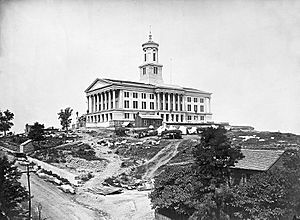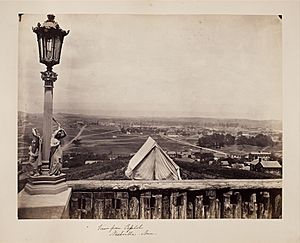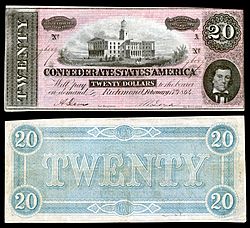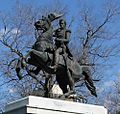Tennessee State Capitol facts for kids
|
Tennessee State Capitol
|
|
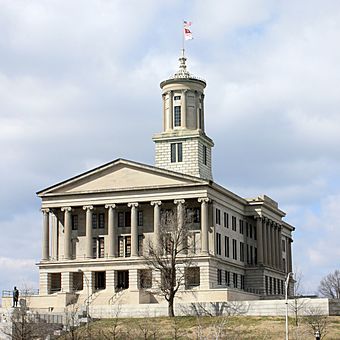
Tennessee State Capitol
|
|
| Location | Capitol Hill Nashville, Tennessee |
|---|---|
| Area | 4.9 acres (2.0 ha) |
| Built | 1845-1859 |
| Architect | William Strickland (1788-1854) |
| Architectural style | Greek Revival style |
| NRHP reference No. | 70000894 |
Quick facts for kids Significant dates |
|
| Added to NRHP | July 8, 1970 |
| Designated NHL | November 11, 1971 |
The Tennessee State Capitol is a very important building in Nashville, Tennessee. It is where the government of the U.S. state of Tennessee works. This building is home to the Tennessee General Assembly, which is where the state's lawmakers meet. It also has the office of the governor.
A famous architect named William Strickland designed the Capitol. He lived from 1788 to 1854. The building was constructed between 1845 and 1859. It is a great example of the Greek Revival architecture style in Nashville. The Tennessee State Capitol is special because it is one of only 12 state capitol buildings in the United States that does not have a large dome on top. In 1970, it was added to the National Register of Historic Places. The next year, in 1971, it was named a National Historic Landmark. The tomb of James K. Polk, who was a U.S. President, is also located on the Capitol grounds.
How the Capitol Was Built
The Tennessee State Capitol stands on a well-known hilltop in Nashville. Before the Capitol was built, an old church called Holy Rosary Cathedral was located there. This church was the first Roman Catholic cathedral in Nashville.
The architect, William Strickland, designed the Capitol to look like an ancient Greek temple. The special structure on the roof, called a lantern, was inspired by a Greek monument in Athens. This monument honored the Greek god Dionysus. The first stone for the Capitol was placed on July 4, 1845. The building was completely finished fourteen years later, in 1859.
The American Society of Civil Engineers has recognized the Capitol as a historic engineering landmark. This is because of its smart way of building. It used a lot of stone and was one of the first buildings to use strong iron in its structure. Both the inside and outside of the Capitol are made from limestone. This stone came from a quarry about 1 mile (1.6 km) away. Some of the columns inside are made from single, huge pieces of stone. Workers used large wooden cranes to lift these heavy stones into place. The roof was built with wrought iron instead of wood. This made the building much safer from fires.
Different types of workers helped build the Capitol. This included paid workers and people who were forced to work. From 1845 to 1847, fifteen enslaved Black men carved the Capitol's limestone basement. A stonemason from Nashville was paid for their work. This project is thought to be the most important time the Tennessee state government used enslaved labor.
William Strickland, the architect, passed away five years before the Capitol was finished. He is buried inside the building's northeast wall. His son, F. W. Strickland, made sure the building was completed. William Strickland also designed St. Mary's Cathedral and the Downtown Presbyterian Church in Nashville.
Samuel Dold Morgan (1798–1880) was in charge of the State Building Commission. This group oversaw the Capitol's construction. He is buried in the southeast corner of the building, near the south entrance.
Monuments and Statues
Many important monuments and statues are on the Capitol grounds. There are statues of two U.S. Presidents from Tennessee: Andrew Jackson and Andrew Johnson. The statue of Andrew Jackson was made by Clark Mills. The one of Andrew Johnson was made by Jim Gray. The second President from Tennessee, James K. Polk, is buried here with his wife, Sarah Childress Polk.
Other memorials on the grounds include:
- The Sgt. Alvin C. York Memorial by Felix de Weldon.
- The Tennessee Holocaust Commission Memorial.
- The Sam Davis Memorial.
- The Memorial to Africans during the Middle Passage.
There is also the Charles Warterfield Reliquary. This is a group of broken limestone pieces that were saved from the Capitol during a repair project in the 1950s.
In May 2020, a statue of Sen. Edward Ward Carmack was taken down by protestors. This happened during a demonstration. The area near where the statue stood has been called "Ida B. Wells Plaza" by protestors. Ida B. Wells was a brave anti-lynching advocate.
Since 1978, a bust (a statue of just the head and shoulders) of Nathan Bedford Forrest has been inside the building. This bust has caused some debate. In 2017, there was a proposal to move it to the Tennessee State Museum.
Images for kids
See also
In Spanish: Capitolio del Estado de Tennessee para niños




